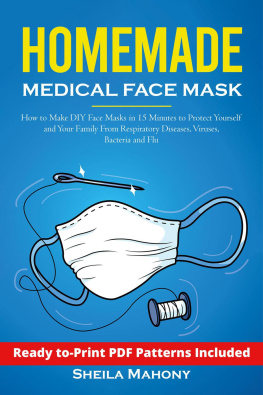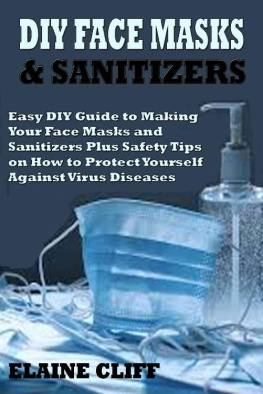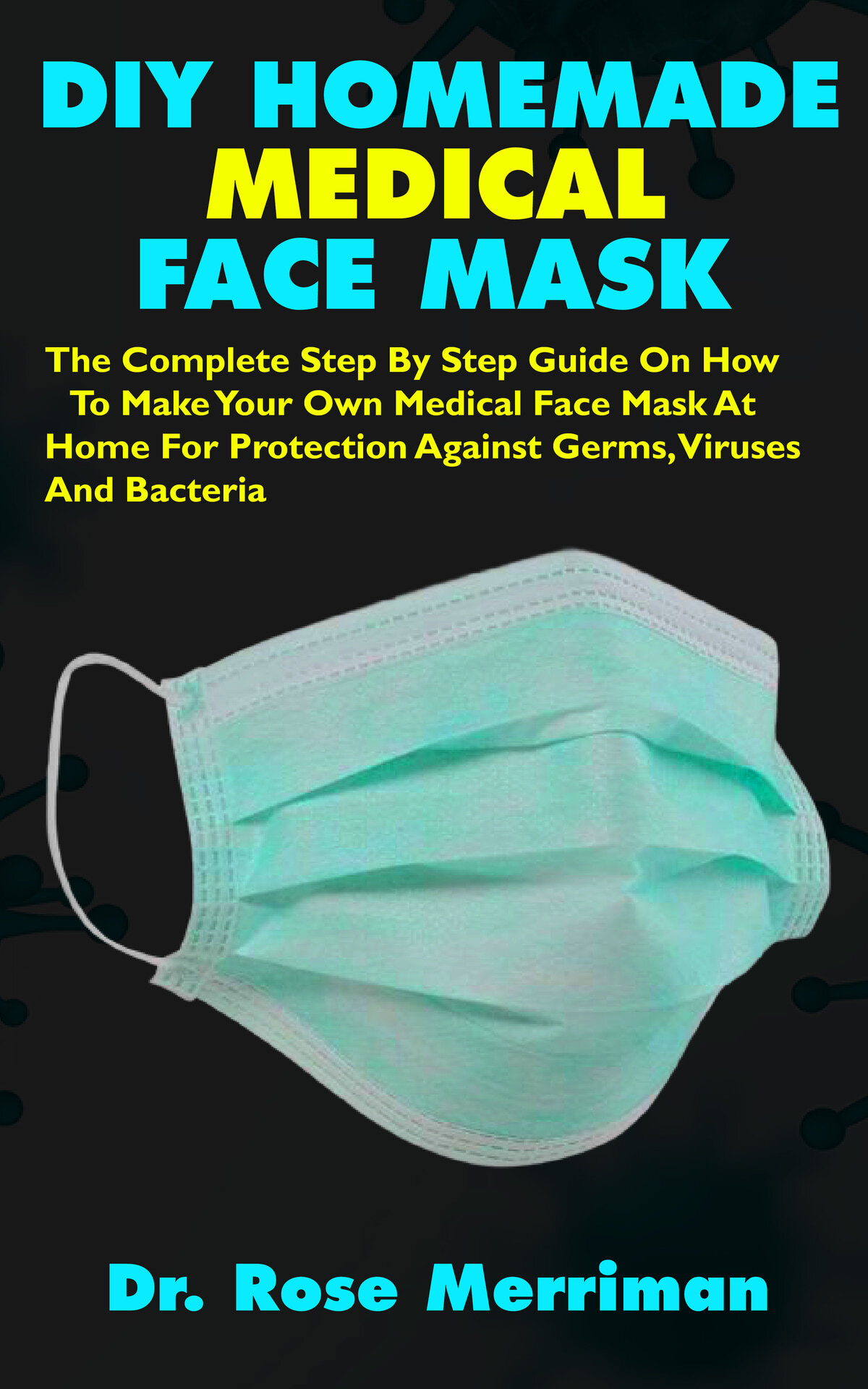DIY HOMEMADE MEDICAL FACE MASK
The Complete Step By Step Guide On How To Make Your Own Medical Face Mask At Home For Protection Against Germs, Viruses And Bacteria
Dr. Rose Merriman
Copyright 2020 by Dr. Rose Merriman
All right reserved. This book is copyright, and no part may be reproduced or transmitted through any means, be it mechanical, electronic, internet, or otherwise without the permission of the author except in brief quotation or review of the book.
Table of Contents
Introduction
Wearing a face mask during the flu season can protect you from inhaling bacteria, germs, microbes and pathogens thatd spread diseases down your respiratory tracts. Also, the face masks help to avoid constant touching of your mouth and nose by hand; these bacteria carrying these infectious diseases easily get access through the mouth and disease. Also, you need the face mask when caring for a victim of these infectious diseases.
In this book, youll learn how to make a medical face mask by yourself, how to wear the face mask, layers of a medical face mask; these and many more youll get to learn from this guide.
CHAPTER ONE
What is Face Mask?
Medical masks are kits that can be used to inhibit the spread of respiratory infections and other similar infectious diseases.
Medical masks are a type of personal protective kit that is used to inhibit the spread of respiratory infections. These masks cover the wearer's mouth and nose and, if used correctly, can be effective in helping to prevent the spread of respiratory viruses and bacteria.
There are two major categories of masks used to prevent respiratory infection: surgical masks, sometimes called medical masks, and respirators. These masks differ depending on the type and size of infectious particles that they can filter. Face masks are most commonly used for respiratory viruses that spread through droplets that travel short distances and are transmitted by coughing or sneezing. Face masks often fit loosely and prevent the user from scattering large sprays and drops, as well as avoiding hand-to-face contact. N95 respirators block 95% of the particles in the air. They fit well and prevent inhalation of smaller infectious particles that can spread through the air over long distances after an infected person coughs or sneezes. Diseases that require the use of an N95 respirator include tuberculosis, chickenpox, and measles. The N95 respirators arent advisable for people with facial hair or by children because it is difficult to achieve a firm fit. In those cases, a special respirator called a powered respirator can be used to purify the air.
Types of face masks
There are two general types of masks: surgical and filter masks. Within the second type of mask, theres a subdivision with three different models that are distinguished in the size of the filter.
Surgical Masks
They are mostly used in the operating theatre. Basically, they are not meant to stop transmission of infectious diseases, but to protect against fluid splashes. Medical personnel wears these masks so that the patient's blood does not sip into their mouth.
The barrier they create is physical, but the WHO has noticed that they are ineffective in preventing infection. Road use is a placebo for those using it compared to COVID-19, rather than a preventative measure.
Filter Masks
These type of masks contain a filter on their forehead that do not allow microparticles to sip from the outside to the inside. There are three filter levels:
First level: this is also called FFP1 or P1, it is the least effective of this category to protect from contagious aerosols. They are used for work with torpid particles, such as brick dust in construction.
Second level: FFP2 or P2 masks are a type of device that filters up to 92% of circulating particles, allowing a maximum of 8% to pass into the interior. The WHO recommends against coronavirus, masks that filter 95% or more; that is, this type is at the limit of the recommendation.
Third level: these types of masks only allow about 2% of the circulating particles to permeate.
When to use the Face Masks?
Use them only if you have respiratory symptoms; this can be a cough or sneeze.
If you have any contagious or infectious disease such as Covid-19.
If you are caring for someone with a suspected case of infection.
Healthcare workers must use it.
How to Wear and Discard a Mask?
Always wash your hands with an alcohol-based sanitizer or soap and water before touching the mask.
Always check the mask for tears or holes.
Turn the top-up (where the metal strip is located).
Ensure to figure out the correct side of the mask (the colored side).
Put the mask on your face. Nip the metal strip or firm edge of the mask so that it adjusts to the shape of your nose.
Drawdown on the bottom of the face mask to properly cover your mouth and chin.
After using it, take off your mask; Remove the elastic straps from behind the ears keeping the mask away from your face and clothing so as not to touch the potentially contaminated surfaces of the mask.
Discard the mask in a closed container straightaway after use.
Always wash your hands with soap and water or alcohol-based sanitizer after touching or discarding the face mask.
Caring For and Disposing of Your Mask
Whether you choose to make your face mask or buy one, the WHO suggest you keep these tips in mind when using it and disposing of it:
Always wash your hands before putting on the face mask.
When wearing the mask, ensure it covers your mouth and nose fully. Avoid any gaps if possible.
Dont touch the mask after you have worn on.
When the interior portion of the face mask becomes damp, discard it and replace it with a new one.
The only part of the homemade face mask you can use again is the plastic face shield. However, sterilize with alcohol or bleach solution before reusing it.
Stop touching the front of the face mask when you remove it. Rather, remove it by the elastic loops.
Throw the mask away after use. Wash your hands with soap or use hand sanitizer after touching it.
Tips for Protection
Wash hands frequently.
Always cover your mouth with your elbow or a tissue when you cough and do the same when you sneeze.
Keep a distance of at least 1 meter from people with flu-like symptoms. For example, people who cough or sneeze.
Abstain from touching your mouth, eyes and nose.
Layers of DIY Face Masks
The WHO claims that a face mask doesn't protect the public from infectious diseases like coronavirus or flu. Masks help those who care for sick people and can prevent the disease from spreading if worn by sick people. Scientists from the University of Hong Kong-Shenzhen Hospital and their cohorts worked together to study the efficiency of the medical masks available for purchase and to create a plan for making your face masks in times of deficiency. Laboratory tests showed that the masks were 80% to 90% as effective at filtering out aerosol and droplets as purchased surgical masks. While these masks aren't as effective as the ones you can buy, the research team did some rigorous testing and found that an effective mask takes three layers:







